What should I eat? It’s a simple question that stirs up conflicting answers—and a lot of confusion.
Vegans, vegetarians, and paleos debate the pros and cons of dairy, grains, beans, even bacon.
According to food writer Mark Bittman and Dr. David Katz, MD, founder/president of the True Health Initiative and author of the book “The Truth About Food: Why Pandas Eat Bamboo and People Get Bamboozled,” humans are the only species confused about how to feed ourselves. “Every wild species on the planet knows how to do it,” they write, “presumably ours did, too, before our oversized brains found new ways to complicate things.”
But eating doesn’t have to be complicated. There’s one simple truth, grounded in science, that nutritionists, dietitians, functional medicine doctors, and public health experts around the globe would all agree on, whether they get their protein from beans or grass-fed beef. And it is summed up in two words: Eat clean.
Clean eating isn’t a diet, and it doesn’t eliminate any food groups. It’s about filling your plate with whole or minimally processed foods (fruits, veggies, fish, lean meat, whole grains, nuts, legumes) and observing how those foods make you feel so you can make the best choices for your body’s needs.
Here are five clean eating principles that will simplify your life.
1. Whole Foods Have a Single Ingredient
Just one. Think avocados, chicken, blueberries, broccoli. Minimally processed means a short ingredients list. For instance, eat whole grain bread made from stone-ground whole wheat flour, yeast, water, and salt.
Food for thought: “Real, whole, and minimally processed foods have high-quality protein, carbohydrates, fats, vitamins, minerals, and antioxidants that provide your body with the nutrients it needs for optimal health,” says Adam Perlman, meQuilibrium’s chief medical officer. “Packaged foods are processed for longer shelf lives with preservatives and other additives and often have less healthy nutrients. “When you’re not getting the raw materials you need, you won’t feel your best, emotionally, physically, or mentally.”
2. There’s No Such Thing as a “Bad” Food Group
(Except for junk food!) According to Bittman and Katz, one of the most misleading ideas about diet and health is that carbs are the enemy. Everything from black beans to jelly beans is a carbohydrate source. So if all carbs are evil, that means veggies and fruit. You cannot eat a healthful diet without carbohydrate sources.
Food for thought: Highly processed grains, fast food, and added sugar are bad, not because they’re carbohydrates, but because they’re low in nutrients, they raise blood sugar levels, and often have added fats, sodium, and other weird ingredients. (Same goes for saturated fat. In and of itself it isn’t “bad”—some very nutritious foods have it. It’s only a problem when we get too much.)
What matters most in our diet is balance. Humans evolved around the globe, from the Arctic to the desert to the tropics and nourished themselves from wildly different food sources. Bear in mind, none of those natural sources included pepperoni or Big Macs.
3. Plants Rule
Though there’s no one best diet, there is a theme: an emphasis on vegetables, fruits, whole grains, beans, lentils, nuts, seeds, and plain water for thirst. That can be with or without seafood; with or without dairy; with or without eggs; with or without some meat; high or low in total fat.
Food for thought: There is abundant evidence that diets of whole, minimally processed food; plant-based diets; and even plant-exclusive diets can prevent and reverse disease. The benefits of plant-predominant diets can be measured in years of life, and life in years.
4. Think About How Foods Make You Feel
When we embrace a specific diet, we allow the diet to make our food choices for us rather than considering what our bodies want or need.
Food for thought: There is no “one best diet” for everyone. The foods that are right for you depend on your age, food sensitivities, and medical conditions. For instance, maybe you’re on the (low-carb) paleo diet (because your friend raved about it) but you notice that the “plumbing” is a little backed up, or that by the end of the day your energy is flagging more than when your diet includes energy sources like beans and grains. Eating healthfully means eating what’s right for you.
5. Conventional Wisdom Doesn’t Change
Really, it doesn’t. So don’t get caught up in the latest food trends. The definition of a healthy diet—“eat food, not too much, mostly plants”—has been clear to nutrition experts for generations.
Food for thought: To avoid the pitfalls, focus on foods, not nutrients. A diet may be higher or lower in fat, or carbohydrate, or protein, and still be optimal. If you get the foods right, the nutrients sort themselves out. When you focus on a single nutrient you quickly learn that there are many ways to eat badly.
If you eat a balanced diet of real food, you really don’t have to worry about much else. “Clean eating is about doing your best,” says Perlman, “one healthy choice at a time.”
